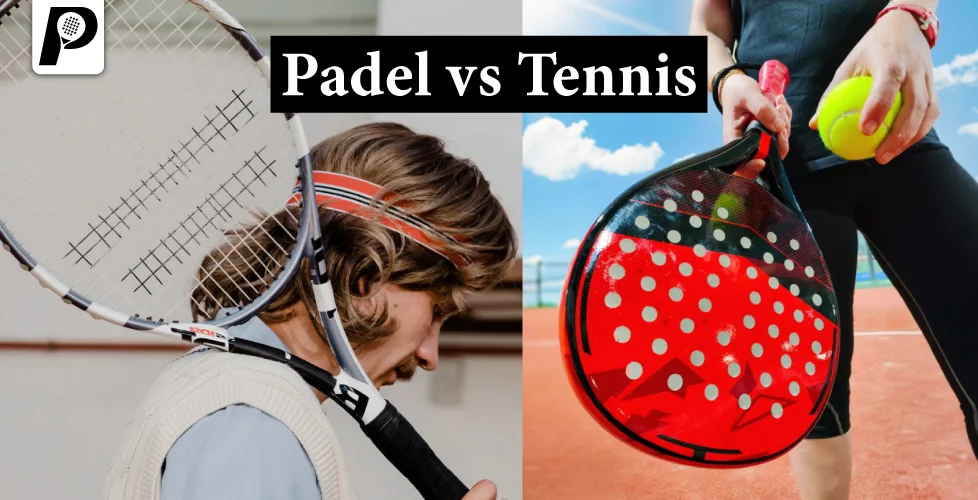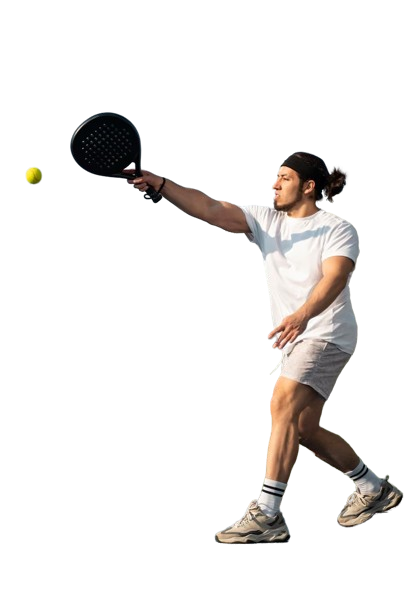Sports enthusiasts are always on the lookout for new and exciting ways to stay active and entertained. Padel and tennis are two racket sports that have captured the attention of many, each offering unique experiences and challenges. While they share some similarities, padel and tennis have distinct differences that set them apart. In this blog, we’ll explore Padel vs Tennis and these differences to help you understand what makes each sport special.
Related blog Padel vs. Tennis: Key Differences and Similarities
Origins and Popularity
originated in England in the late 19th century and quickly became a global sport, celebrated for its prestigious tournaments and legendary players. **Padel** invented in Mexico in 1969, gained popularity in Spain and Latin America before spreading worldwide, with its social and accessible nature contributing to its rapid growth in Europe and South America.
Tennis
Tennis is a globally recognized sport with a rich history dating back to the 19th century. Originating in England, it quickly spread across the world, becoming a staple in both recreational and professional sports. Major tournaments like Wimbledon, the US Open, and the French Open have cemented tennis’s place as a prestigious and widely followed sport. Tennis has produced legendary athletes such as Roger Federer, Serena Williams, and Rafael Nadal, whose matches captivate millions of fans worldwide.
Padel
Padel, on the other hand, is a relatively newer sport, invented in Mexico in 1969 by Enrique Corcuera. It gained popularity in Spain and Latin America before spreading to other parts of the world. While not as globally recognized as tennis, padel is rapidly growing, particularly in Europe and South America. Its social and accessible nature makes it appealing to a broad audience. Countries like Spain and Argentina have seen a significant rise in the number of paddle courts and players, with professional circuits and tournaments contributing to its expanding popularity.
Related blog What is Padel? Exploring the Equipment, Rules, and Strategies
Court and Equipment
Tennis courts are larger, measuring 23.77 metres by 8.23 metres, with varied surfaces and traditional stringed rackets. **Padel** courts are smaller at 20 metres by 10 metres, enclosed by walls, and use solid perforated rackets, with balls designed for a slower, controlled bounce.
Tennis Court
A standard tennis court is larger than a padel court, measuring 23.77 metres (78 feet) in length and 8.23 metres (27 feet) in width for singles matches, with a slightly wider dimension for doubles. The court is divided by a net and features specific markings for service boxes and baseline play. Tennis rackets are larger and stringed, typically measuring between 27 and 29 inches in length, and the balls are designed for high-speed play and long rallies. The court surface can vary, with grass, clay, hard, and artificial surfaces each offering different playing conditions and challenges.
Padel Court
A padel court is smaller, measuring 20 metres (65.6 feet) in length and 10 metres (32.8 feet) in width. It is enclosed by walls made of glass or metal mesh, which players can use strategically during play. The net in padel is slightly lower than in tennis, set at 88 centimetres (34.6 inches) at the centre. Padel rackets are solid with perforations, shorter handles, and a maximum length of 45.5 centimetres (17.9 inches). The balls are similar to tennis balls but with slightly less pressure, resulting in a slower and more controlled bounce.
Related blog How Playing Padel on a Padel Court Enhances Mental and Physical Well-being
Gameplay and Scoring
Tennis features fast-paced play with serves from behind the baseline and points scored when the ball is not returned within the court boundaries, with matches often played in best-of-three or five sets. **Padel** involves underhand serves, the use of walls for strategic shots, and longer rallies, with matches typically played in best-of-three sets using a point system similar to tennis.
Tennis Gameplay
It is played as singles (one player on each side) or doubles (two players on each side). The game starts with a serve from behind the baseline into the opponent’s service box. Points are scored when the opponent fails to return the ball within the court boundaries or commits a fault. The game is fast-paced, requiring a combination of power, precision, and endurance. Matches are typically played in best-of-three or best-of-five sets, with each set consisting of games scored using the familiar 15-30-40-game point system.
Padel Gameplay
Padel is predominantly played as a doubles sport, although singles play is possible on smaller courts. The serve is underhand, and the ball must bounce once before being hit. The enclosed court and the use of walls introduce a new dimension to the game, as players can use these surfaces to create strategic shots. Padel emphasises teamwork, quick reflexes, and tactical play. The scoring system is similar to tennis, with matches usually played in best-of-three sets and games scored using the same 15-30-40-game point system. However, the rallies tend to be longer and more dynamic due to the smaller court size and wall interactions.
Related blog How to Play Padel: Common Mistakes and How to Avoid Them
Playing Style and Strategy
Tennis strategies involve powerful serves, precise groundstrokes, and a mix of baseline and net play, focusing on individual skills and endurance. Padel emphasises teamwork, quick reflexes, and the strategic use of walls, with players often utilising lobs and volleys to navigate the smaller, enclosed court.
Tennis Strategy
Tennis strategy involves a mix of baseline play and net approaches, with an emphasis on powerful serves and groundstrokes. Players aim to outmanoeuvre their opponents through precise shot placement, varying spin and speed, and maintaining stamina for extended rallies. Singles matches require individual skill and endurance, while doubles matches focus on coordinated teamwork and communication. Key strategies include serve-and-volley, baseline dominance, and counterpunching, with players constantly adapting to their opponent’s strengths and weaknesses.
Padel Strategy
Padel strategy revolves around using the walls, positioning, and quick volleys. Since the court is smaller and enclosed, players need to be agile and anticipate their opponents’ moves. Teamwork is crucial, with partners working together to cover the court effectively and set up points. The game often involves a mix of offensive smashes and defensive lobs, making it a dynamic and engaging sport. Padel players frequently use the walls to their advantage, creating unique angles and shots that are not possible in tennis. Effective communication and positioning are essential for success in padel, with players often switching sides and covering each other’s movements.
Related blog How to Improve Your Game with the Right Padel Racquet
Social Aspect
Tennis can be competitive and formal, with a strong emphasis on etiquette and individual play, though doubles matches and club activities offer social opportunities. **Padel** is inherently social, designed for doubles play with a focus on community and interaction, making it a popular choice for groups and recreational play.
Tennis
It is often seen as a competitive and individual sport, though doubles play offers a social element. Players can join clubs, participate in leagues, and compete in tournaments at various levels. The social aspect of tennis can be more formal, with etiquette and tradition playing significant roles in the sport. Tennis clubs often provide social events, group lessons, and competitive ladders, fostering a sense of community among players.
Padel
Padel is inherently social, designed to be played as doubles and fostering a community spirit. The smaller court and slower pace make it accessible to players of all ages and skill levels. Padel clubs often emphasise the social experience, with many facilities offering amenities like lounges, social events, and casual play sessions to encourage interaction among players. The inclusive nature of padel makes it a popular choice for families, friends, and colleagues looking to enjoy a fun and engaging activity together.
Physical Demands and Accessibility
Tennis requires significant physical fitness, agility, and endurance due to the larger court size and longer rallies. **Padel** is generally more accessible, with a smaller court and lower physical demands, making it easier for beginners and those with varying fitness levels to enjoy and excel in the game.
Tennis
It is a physically demanding sport that requires a high level of fitness, agility, and endurance. The larger court size means players need to cover more ground, resulting in longer rallies and greater physical exertion. Tennis can be challenging for beginners due to the need for technical skills such as proper grip, stroke mechanics, and footwork. However, it offers a rewarding experience for those willing to invest time and effort into improving their game.
Padel
Padel is often considered more accessible than tennis, particularly for beginners and recreational players. The smaller court size and use of walls reduce the physical demands, allowing players to focus on strategy and positioning rather than pure athleticism. Padel’s slower pace and forgiving nature make it easier for new players to pick up and enjoy the game quickly. The emphasis on teamwork and communication also enhances the social and inclusive aspects of the sport.
Related blog Why Padel Haus is the Top Choice for Padel Enthusiasts
Conclusion
While Padel vs Tennis shares some common ground as racket sports, they offer distinct experiences that cater to different preferences and playstyles. Tennis is a sport of tradition, power, and precision, with a global following and prestigious tournaments. Padel, with its emphasis on social interaction, strategic use of walls, and accessible gameplay, is rapidly gaining popularity as a fun and engaging alternative.
Whether you prefer the classic appeal of tennis or the dynamic, social nature of padel, both sports provide excellent opportunities for physical activity, skill development, and enjoyment. So grab your racket—whether stringed or solid—and hit the court to experience the unique thrills of tennis and padel!







